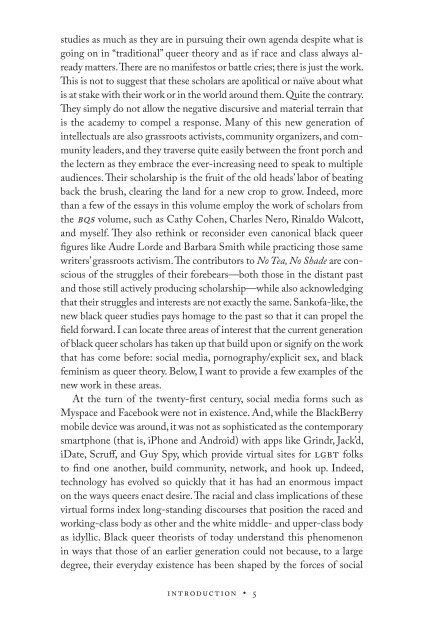No Tea
89AS6wvrf
89AS6wvrf
You also want an ePaper? Increase the reach of your titles
YUMPU automatically turns print PDFs into web optimized ePapers that Google loves.
studies as much as they are in pursuing their own agenda despite what is<br />
going on in “traditional” queer theory and as if race and class always already<br />
matters. There are no manifestos or battle cries; there is just the work.<br />
This is not to suggest that these scholars are apo liti cal or naïve about what<br />
is at stake with their work or in the world around them. Quite the contrary.<br />
They simply do not allow the negative discursive and material terrain that<br />
is the acad emy to compel a response. Many of this new generation of<br />
intellectuals are also grassroots activists, community organizers, and community<br />
leaders, and they traverse quite easily between the front porch and<br />
the lectern as they embrace the ever- increasing need to speak to multiple<br />
audiences. Their scholarship is the fruit of the old heads’ labor of beating<br />
back the brush, clearing the land for a new crop to grow. Indeed, more<br />
than a few of the essays in this volume employ the work of scholars from<br />
the bqs volume, such as Cathy Cohen, Charles Nero, Rinaldo Walcott,<br />
and myself. They also rethink or reconsider even canonical black queer<br />
figures like Audre Lorde and Barbara Smith while practicing those same<br />
writers’ grassroots activism. The contributors to <strong>No</strong> <strong>Tea</strong>, <strong>No</strong> Shade are conscious<br />
of the strug gles of their forebears— both those in the distant past<br />
and those still actively producing scholarship— while also acknowledging<br />
that their strug gles and interests are not exactly the same. Sankofa- like, the<br />
new black queer studies pays homage to the past so that it can propel the<br />
field forward. I can locate three areas of interest that the current generation<br />
of black queer scholars has taken up that build upon or signify on the work<br />
that has come before: social media, pornography/explicit sex, and black<br />
feminism as queer theory. Below, I want to provide a few examples of the<br />
new work in these areas.<br />
At the turn of the twenty- first century, social media forms such as<br />
Myspace and Facebook were not in existence. And, while the BlackBerry<br />
mobile device was around, it was not as sophisticated as the con temporary<br />
smartphone (that is, iPhone and Android) with apps like Grindr, Jack’d,<br />
iDate, Scruff, and Guy Spy, which provide virtual sites for lgbt folks<br />
to find one another, build community, network, and hook up. Indeed,<br />
technology has evolved so quickly that it has had an enormous impact<br />
on the ways queers enact desire. The racial and class implications of these<br />
virtual forms index long- standing discourses that position the raced and<br />
working- class body as other and the white middle- and upper- class body<br />
as idyllic. Black queer theorists of today understand this phenomenon<br />
in ways that those of an earlier generation could not because, to a large<br />
degree, their everyday existence has been shaped by the forces of social<br />
Introduction • 5


